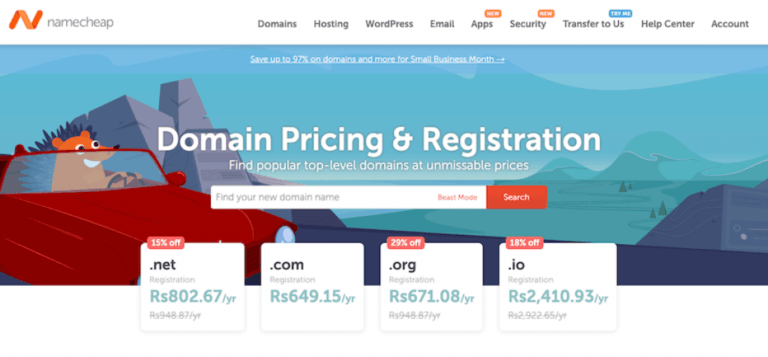A Practical Guide For Growing Blog Traffic
A Practical Guide For Growing Blog Traffic
Why Do You Want To Start A Blog?
There are three fundamental causes behind this.
- First and foremost, blogging can be a great deal of pleasure. It's a creative hobby that lets you express yourself while sharing your ideas with a massive audience if done effectively.
- Second, blogging may help you (or your company) position yourself as an expert in your subject.
- Finally, blogging can dramatically increase the number of visitors to your website.
According to inbound marketing gurus Hubspot, businesses that blog regularly receive 55 percent more visitors than those that don't. As a result, if you write effectively and blog about a topic many people are interested in, your website may get a lot of visitors.
Want to Start Making Money Online?
Try My #1 Recommendation Program!
And we all know what having many visitors to your website means: more sales and cash. But how do you go about starting a blog that will be successful? As you would imagine, the first stage is locating a decent writer.
1. Find The Best Writer For The Job! (Hint: It's Probably Not You)
Writing excellent content is at the core of getting your blog recognized – and bringing a lot of traffic to it. And that material will be much better if the individual creating it is informed and enthusiastic about the subject. Blog pieces produced from the heart – rather than by a content farm or an AI bot – are significantly more likely to pique people's attention and, more importantly, to be shared.
However, it's possible that you're not the best person to create the entries for your website. Maybe you're not a very good writer. Perhaps you don't have enough time to blog. If you identify with any of those comments, consider hiring a writer capable of producing genuinely excellent blog content and willing to put in the time to do it.
Whoever authoring the blog articles on your website must have a distinct personality. Readers relate with authors because there is much to appreciate — or perhaps loathe — about their personality, mouthiness, or vocal tone. If a reader loves YOU as a writer, rather than merely the quality of the stuff you provide, your blog is far more likely to gain a loyal audience.
As a result, ensure that your individuality shines through in your writing. This helps you build a relationship with your readers, who may be more likely to return to your site because of liking you as a person. It's time to think about what to write about now that you've identified your writer and tone. Let's take a closer look at it.
2. Conduct Keyword Research To Come Up With Suitable Blog Subjects
It's pretty simple to sit down and compose blog entries that go into great detail on issues that no one cares about! Similarly, it's simple to produce a blog article on something people ARE interested in but to label it with terms and phrases that no one searches for. Here, keyword research is your friend: it can help you develop fantastic blog post ideas and guarantee that your material has a sizable target audience.
You may learn the number of monthly searches for different keywords — and how tough it is to rank for specific terms — by utilizing keyword research tools like Semrush or Ahrefs. The goal is to find words that produce a good quantity of traffic yet don't have a lot of competition for you to employ on your site.
After completing your keyword research, ensure your keywords appear in all of the appropriate locations throughout your piece. This entails including them in your posts. We'll get to all of them in a minute, but first, let's look at a general crucial to compelling blog posts: length.
3. Make Your Blog's Long-Form Material A Priority
According to studies, ‘long-form content' outperforms short or ‘thin' postings in search results. It's all about the size! Long-form content refers to articles with long word counts that delve into great detail on a subject. There are a few reasons why long-form material aids in generating better rankings in search results.
- For starters, lengthier postings will naturally be more keyword-rich, making them more likely to appear in searches for “long tail” keywords (search queries involving combinations of several words).
- Second (and maybe more crucially), a lengthy post's in-depth character is more likely to please readers who come across it – it will be more likely to answer your visitor's question or solve their issue.
Consequently, the article is more likely to be shared on social media or linked to other websites, resulting in increased traffic.
4. Update Existing Blog Entries To Keep Your Material Current
If you do any study on blogging and SEO, you'll find many articles that emphasize the need to create ‘fresh' material to get excellent search results and visitors to your site. However, I would advise against misinterpreting this just to create new postings.
When it comes to my material, I've found that focusing on quality over quantity is much more beneficial – rather than posting every day simply for it, I spend a lot of time making sure that what I already have is as good (and as in-depth) as possible.
This is accomplished by regularly examining earlier entries and updating them with the most up-to-date information. This is especially crucial in product evaluations, but even ‘evergreen material' (articles that provide information that doesn't change much, if at all) might benefit from freshening up.
Want to Find Out How To Start Your Home-Based Business?
Try My #1 Recommendation Platform!
This sends Google the ‘freshness' signals that the search engine's algorithms like, and it also often lengthens postings and helps offer the ‘long-form' material that performs better in search results. However, publishing fresh articles regularly has obvious benefits: the more material you have on your site, the more keywords you may rank for. But only if the topic is compelling!
5. Use Fantastic Photos To Go Along With Your Blog
It's critical to include high-quality photographs in any blog entries you write. This is due to four key factors.
- First, it gives readers a feeling of what you're talking about (this is especially crucial if you're talking about complicated subjects – visual aids may assist).
- Second, anytime your visitors share one of your posts on social media, the primary photo accompanying it will frequently appear. If it's a dull image, it'll be less likely to create click-throughs to your site.
- Third, much like text, photographs may be optimized to improve the visibility of your content in search results. You can assist search engines in understanding what your article is about by including relevant keywords in the image's ‘alternative text,' file name, and caption (which in turn can help your post appear more often in relevant search results).
- Finally, excellent photographs contribute to the authority of your material. If you include a gorgeous piece of photography in a blog article instead of a cheap-looking piece of clip art, folks who stumble on it are significantly more inclined to take it seriously — or even read it in the first place.
6. Make Your Blog Entries Search Engine Friendly
To give your blog entries the best chance of doing well in search, you need to execute a number of technical measures referred to as ‘on-page SEO.'
Always remember to:
- Use keyword-rich headers (H1, H2, H3, H4, etc.) to break up material
- Use keyword-rich alt text and file names for your photos
- Add keywords in each post's URL that reflect the content
How To Target Great Keywords In Blog Posts To Rank On Google's First Page
You may also do a few ‘technical SEO‘ actions. Google favours content that loads fast, and there are a few factors that might assist in this regard:
- Creating a Google Search Console account for your website
- reducing the size of all picture files as much as possible (without being too pixelated)
- adhering to Google's new ‘Core Web Vitals' requirements for performance and stability – eliminating the usage of redundant scripts on the page
Important: don't forget to optimize your blog content for ‘real' visitors too!
It's easy to get caught up in everything you can do to make a search algorithm like your blog content – and forget that you're trying to wow people! There are a few things you can do to improve the attractiveness of your blog article to ‘real' readers:
Avoid jargon and sophisticated terminology – a huge majority of the individuals reading your blog entries will be completely unfamiliar with the issue you're addressing, so use simple language and explain ideas plainly wherever feasible.
On your blog, choose fonts that are generally big and simple to read.
Make sure your blog has a ‘responsive' design, which means it adapts its appearance to the device it's being read on (mobile, tablet, laptop etc.).
Make sure your blog posts load quickly; a slow-loading article will deter readers from reading it.
7. Take Down Email Addresses
Once people visit your site, you should always try to get their email addresses. This enables you to send out e-newsletters to your readers, informing them of new blog entries, which may result in a considerable increase in traffic and social shares. To successfully collect email addresses, include a mailing list sign-up form on each blog post, not simply on a ‘sign up to our mailing list' page on your website. You may use a sidebar, pop-up box, or a simple text call-to-action to encourage individuals to join your mailing list.
Remember to lay out the advantages of joining the list — the value that your site visitor will get by being a subscriber — while building this sign-up form. Instead of a dull ‘join our mailing list' call to action, emphasize the fantastic materials a member can anticipate getting, the skills they'll gain, and so on.
Are You Tired Of Scams?
Try The Most-Trusted Training Platform To Make Money Online!
Suppose you use an email marketing solution (like GetResponse, AWeber, Mailchimp, or Mad Mimi). In that case, you can utilize your RSS feed to fuel your e-newsletters, which means that whenever you publish a new blog post, your subscribers will get an e-newsletter notifying them of the new material.
8. Encourage Others To Share On Social Media
Encourage your readers to share your blog entries by making specific calls for people to share your material on Twitter, Facebook, and other social media platforms. Not only should you experience an increase in traffic to your articles if they follow these suggestions, but you may also be sending subtle ‘signals' to search engines about the popularity and quality of your postings.
In this case, using a tool like Sumo or Addthis – which enables you to add a variety of sophisticated social sharing icons and data gathering forms to different places on your website – may assist.
9. Encourage User Participation And Comments
Encourage individuals to comment at the bottom of your articles with their own thoughts. There are three reasons for this to be advantageous:
- It makes your website's content more keyword-rich (that can be indexed and ranked highly by Google).
- It might motivate people to come back to your site because of the debates in the comments area.
- Some SEO experts feel that Google favours blog entries that create a lot of community debate over those that don't – presumably because it boosts the time people spend on the page.
10. Create High-Quality Backlinks To Your Articles
At its most basic level, there are two essential requirements for a blog article to rank in search:
- First and foremost, your article must include high-quality material.
- Second, it must have a large number of backlinks going to it from other respectable websites.
We spoke about ‘quality content' earlier, and you should concentrate on generating long-form pieces that clearly and thoroughly address the subject you're writing about. Always strive to answer the reader's question or solve their issue.
Obtaining backlinks is often more complex, as it entails contacting many bloggers and website owners and requesting them to add a link to your material in their articles or allow you to write a guest blog post. It's almost like an internet public relations effort. This kind of outreach takes time, but it's necessary, and if done well, it can be highly beneficial.
Another alternative for backlink creation is to engage an agency to do it for you. However, you must be cautious here, as employing an agency or consultant who subsequently places (or worse, buys) links on low-quality sites may frequently do more damage than good.
When it comes to establishing ties:
- Focus on websites with a strong reputation (you can use SEO tools like Ahrefs or Semrush's ‘domain authority scores' to see which ones do and which don't).
- Always check that the connections you're creating make sense in context (for example, if you're linking to a site about shoes, don't link to ice cream postings).
So, what exactly are those guiding principles? They're straightforward. The following should be included in your content:
- The most relevant information on your subject
- Teach a new skill to a reader or go through a topic in more detail.
- Publish just the most valuable information for your target audience, regardless of the sort of content you're writing for your blog.
- It's simple to find. Remove as many hurdles as possible for a target reader to reach your material via a large number of social shares or ranking #1 for a keyword.
Recognize The Sources Of Traffic To Your Blog
Have you checked both of those boxes on your blog's checklist? It's also worthwhile to review your website stats to determine where you started. To figure out where your current blog traffic originates from, use Google Analytics' Traffic Acquisition report. (We'll expand on these ideas later.)
Search Engine
Every day, people use Google to look for a variety of things. On page one, search engine algorithms compile a list of ten URLs that they believe are the most relevant to a user's query. 68 percent of internet encounters begin with a search engine because of the potential to uncover fresh material. But keep in mind that search engines aren't only Google.
You may also search YouTube for videos, SlideShare for presentations, Unsplash for photographs, Twitter for tweets, etc. All you have to do to receive search traffic from these sites is place your content and make sure it's optimized for the keywords people could use to locate it. It's a little more complex than that, to be sure. However, you've already won half the fight by producing high-quality material on all these platforms.
Want To Learn How To Create Your Own Website And Online Business?
Try My #1 Recommendation Training And Hosting Platform!
The Internet And Social Media
I'm willing to wager that if you ask someone where they spend most of their online time, they'll say social media. The daily active users on platforms like TikTok, LinkedIn, and Facebook Groups are rapidly increasing. 82% of people in the United States use at least one social networking site.
Examine your Google Analytics to determine which social media networks bring the most traffic to your blog. You can see a 5-day spike in page visits after each time you promotional material in a Facebook Group. When an influencer reshares your blog article with their audience, page views for the day increase by 30%.
Marketing Through Email
For many individuals, their email inbox is a hallowed sanctuary. More than half of all people check their email first thing in the morning. It's where people interact with the companies they care about, respond to business communications, and, in some circumstances, find new material.
Determine how many new readers you're bringing to your blog with each campaign if you have a mailing list. Calculate the average open rate for blog-related emails, which is the proportion of individuals that received your email and clicked on a link inside it.
Conclusion
It is crucial to have excellent quality blog posts on your website. Sometimes, it is better to write a few top-quality articles weekly than to publish mediocre posts daily.
I trust you enjoyed this article on A Practical Guide For Growing Blog Traffic. Would you please stay tuned for more articles to come? Take care!
JeannetteZ
Want to Learn How to Build Your Own Home-Based Online Business & Start Making Money Online From Your Comfortable Couch?
Try Wealthy Affiliate!
Your Opinion Is Important To Me
Thoughts? Ideas? Questions? I would love to hear from you. Please leave me your questions, experiences, remarks, and suggestions about A Practical Guide For Growing Blog Traffic in the comments below. You can also contact me by email at Jeannette@WorkFromAnywhereInTheWorld.com.
Disclosure
This post may contain affiliate links. I earn from qualifying purchases as an Amazon Associate and other affiliate programs. Read my full affiliate disclosure.
You may also enjoy the following articles:
Wealthy Affiliate Review – Scam or Legit? The Truth Exposed
How To Build Internal Links For SEO In WordPress
Smart Ways To Get More YouTube Subscribers
Best Tips To Create A WooCommerce Store
All About Managed WordPress Hosting












